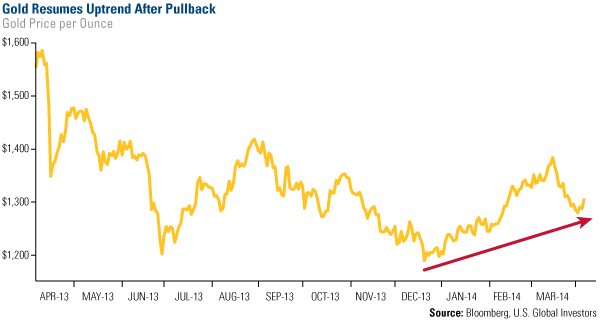Gold Market Radar (April 7, 2014)
For the week, spot gold closed at $1,303.64, up $8.37 per ounce, or 0.65 percent. Gold stocks, as measured by the NYSE Arca Gold Miners Index, rose 0.52 percent. The U.S. Trade-Weighted Dollar Index rose 0.31 percent for the week.
Strengths
- Gold rose $8.37 per ounce for the week, as the futures contract posted its best one-day performance since March 12 on Friday. U.S. payrolls rose 192,000 in March, missing analysts’ expectations for a 200,000 gain. The weekly price action was also supported by positive import estimates from India and expectations of further stimulus in China, where Shanghai physical premiums turned positive.
- Gold sales by Japan’s biggest bullion retailer increased five-fold in March as investors accelerated purchases ahead of the nation’s sales tax increase on April 1. The demand was in response to Prime Minister Abe’s tax hike as the government seeks to address the nation’s swelling public debt and to stoke inflation. Similarly, India’s gold imports are set to more than double in March from February’s 33 tonnes, according to a government official with direct knowledge of the matter.
- Teranga Gold’s annual output in Senegal is set to rise 40 percent as production climbed to 350,000 ounces per year from the previous 250,000 ounces. The company recently made an attractive acquisition to consolidate a land package consisting of nine operating licenses, which helped de-risk the company’s Sabodala gold mine project. In other news, AuRico Gold announced that it completed a cash tender offer for 99.6 percent of its 3.5 percent convertible notes due 2016. The retirement of the convertible notes issue removes an overhang and clears the way for the stock going forward.
Weaknesses
- Data from the U.S. Mint shows that sales of gold coins dropped 32 percent in March from February, despite strong sales for silver coins which rose 43 percent. Similarly, the Perth Mint reported sales of 30,177 ounces in March, down from 47,000 ounces in February.
- Barrick Gold announced that it will unveil new compensation methods for board members and executives following shareholder uproar over previous compensation arrangements. Despite the progress made by Barrick, the decision to address shareholder concerns over executive compensation was long overdue, especially in a lower gold price, low margin environment. Corporate governance issues have been cited frequently by generalist investors as one of the reasons to avoid investments in the sector.
- DRDGold announced that its new fine grind and floatation circuit at Ergo has reduced gold recovery rather than improving it following commissioning in early January. As a result of this setback, first quarter production declined 14 percent and cash costs increased 24 percent, according to management. JP Morgan analysts expect the stock to underperform as there is no guarantee that the new circuit will achieve the expected increase in recovery.
Opportunities
- Both the buy-side and the sell-side are warming up to gold. This week, Pecora Capital, a Florida-based asset manager, said gold will return to a record within five years as weaker equities spur demand for a safe haven. On the sell-side, Deutsche Bank raised its 2014 and 2015 gold price estimates, while Australia and New Zealand (ANZ) Bank raised its views to neutral after being bearish on the metal. ANZ analysts say their physical gold indicator increased toward the end of March, even in the face of a weaker Chinese currency.
- Yamana Gold made a unique offer to acquire 50 percent of Osisko, topping the previous Goldcorp bid. While it is encouraging to see the M&A activity in the sector picking up and a renewed interest in the sector, this particular transaction has evidenced the precarious state of corporate governance in the gold sector. Since 2012, and due to multi-billion dollar write-downs, an unprecedented number of CEOs in the mining space have been fired. As a result, CEOs are looking to protect their seats by bidding for fully valued assets with no execution risk. While one could argue such M&A strategy is more responsible than those previous years, the reality shows it offers higher returns for management than it does for shareholders.
- South Africa’s platinum sector strikes have reached the 10-week mark as auto sales growth in the U.S. reached 10 percent this March, increasing the potential for a price spike amid supply constraints. The strikes, in which the unions have appeared intransigent, may put thousands of platinum workers out of work permanently, as mining companies seek to mechanize mines to halt cost escalation. A recent proposal criticizes the Black Empowerment status quo and calls for profit-sharing programs with employees that align their interests with those of the company and ensure all related parties receive economic benefit, not just the Black Empowerment groups.
Threats
- Natixis analysts argue downside pressures for silver are much higher than those of gold given the average mining costs for silver are around $7 per ounce (Natixis estimate). The bank has a base case for silver at $18.60 an ounce for 2014, and $15 per ounce in 2015, noting that prices could go as low as $10 per ounce. In their view, the liquidation of a portion of the nearly 20,000 tonnes of silver held in exchange traded products (ETPs) is a latent threat to the silver market.
- The new Chilean government headed by President Bachelet has vowed to raise taxes and increase social spending, at the cost of traditional producing sectors like mining. As a result, Codelco, the world’s largest copper producer, and the largest miner in Chile, will appeal to the government to continue assisting in the financing and permitting of projects designed to support the mining industry, which has fueled the country’s growth for decades through the payment of royalties and taxes.
- Executives from Caterpillar are expected to testify next week before a U.S. Senate subcommittee on allegations that the heavy equipment manufacturer used a foreign subsidiary to avoid paying $2.4 billion in U.S. taxes. This type of pressure on corporations to repatriate funds at a massive cost to investors is not new, and we may see more in the mining sector where companies pay taxes in the countries where they operate, not necessarily in the country where their head offices are located.
















